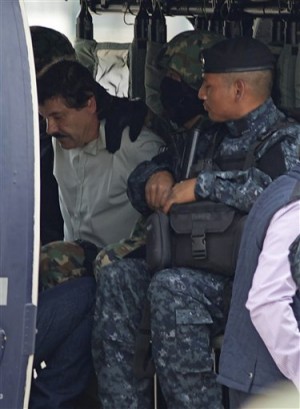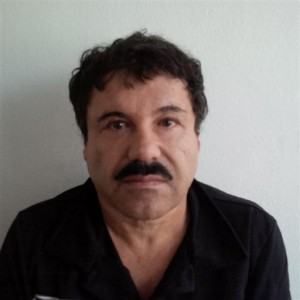Chapo’s Rise: From poor, abused to cartel kingpin

Joaquin “El Chapo” Guzman sits inside a federal police helicopter at a navy hanger in Mexico City, Saturday, Feb. 22, 2014. A senior U.S. law enforcement official said Saturday, that Guzman, the head of Mexicoís Sinaloa Cartel, was captured alive overnight in the beach resort town of Mazatlan. Guzman faces multiple federal drug trafficking indictments in the U.S. and is on the Drug Enforcement Administration’s most-wanted list. AP
It was nighttime in May of 1990, in the heyday of the cocaine boom across America. Twenty Mexican federal police officers and a handful of U.S. Customs agents, acting on a tip, descended on a stucco home on the edge of Agua Prieta, Mexico — a stone’s throw from Arizona. “Policia,” they yelled, guns drawn, before busting down the front door.
The house was empty but looked lived in, with dishes in the kitchen and toys in the backyard. The officers moved quickly to a spacious game room, complete with a bar and a pool table, set atop a 10-by-10 foot concrete panel on the floor.
An informant had told them that what they were looking for was under the pool table. With a jackhammer, the officers went to work. Then, a stroke of luck: One of them turned the knob of a faucet and suddenly the floor and the pool table rose into the air — like a hydraulic lift in an auto shop.
A metal staircase led down to a stunning discovery: Beneath the house, connecting to a warehouse in the U.S. 300 feet away, was an underground tunnel outfitted with lighting, air vents and tracks on the floor to transport carts full of drugs.
It was, at the time, unheard of, a new level of sophistication in the cross-border war on the cartels shipping tons of cocaine and marijuana northbound every year. Still, said retired Customs agent Terry Kirkpatrick: “None of us … looked at it with the vision that this would be the future of drug smuggling.”
Article continues after this advertisementNor did they know then who was behind it: The one they called “Shorty” because of his 5-foot-6 frame, a man who grew up poor and had no formal education but would rise from a small-time Mexican marijuana producer to lead the world’s most powerful drug cartel.
Article continues after this advertisementThe tunnel marked the dawn of a new, craftier and more deadly era in the drug war: the beginning of the reign of “El Chapo.”
A week after his capture in the resort city of Mazatlan, Joaquin “El Chapo” Guzman sits in a cell in Mexico’s highest-security prison, a sprawling complex surrounded by barbed-wire fences.
It is a far cry from the life he lived as the head of Mexico’s Sinaloa Cartel, further still from his beginnings in the mountain village of La Tuna de Badiraguato, Sinaloa, on the country’s Pacific coast. There, Guzman was one of six children of a man who supposedly raised cattle but, authorities have said, actually worked in the region’s main industry — growing and smuggling opium and marijuana.
As a boy, Guzman was physically abused by his father, according to Michael Vigil, a former senior U.S. Drug Enforcement Administration official. He nevertheless followed him into the drug trade and began growing marijuana.
By the late 1970s, when Guzman was in his 20s, Mexican kingpin Hector Luis Palma Salazar placed him in charge of transporting drugs from Sinaloa to coastal cities on their way north to the U.S., according to “The Last Narco,” a Guzman biography. After that Guzman rose quickly through the ranks, and by the early ’80s was supervising logistics for Miguel Angel Felix Gallardo, founder of the Guadalajara cartel.
Guzman worked as a Gallardo lieutenant for years, then emerged as one of the dominant figures on the drug-trafficking scene as Gallardo was hunted by the DEA and eventually arrested for the 1985 murder of agent Enrique “Kiki” Camarena.
“He shows up as an all of a sudden, overnight thing,” said Edward Heath, who ran the DEA’s Mexico office during the Camarena killing. “The guy was smart enough to pick up on how things get done. If someone did not perform well or you become a threat, he would set ’em up. A lot of people got killed. A lot of people got sent to jail.”
As he consolidated power, Guzman began showing a flair for inventive smuggling. According to U.S. prosecutors and federal indictments, he opened a business disguised as an air taxi service and used two Learjets to ferry drugs. In 1989, cocaine concealed as boxes of Mexican soap was shipped into Southern California. In 1992, Guzman and his men opened a hardware store near Los Angeles to import rolls of chicken wire mixed with hidden fiberglass compartments to store cocaine. Even shipments of jalapeno peppers were stuffed with coke.
Then there were the tunnels. “You could call him the godfather of tunnels along the border,” said Kirkpatrick, the agent at the 1990 discovery.
That passageway was the first of many linked to Guzman. About a half-dozen other tunnels were found in ensuing years in California and Arizona that ran the length of several football fields and were equipped with hydraulic lifts and electric rail cars. One stretched 1,400 feet from Tijuana, Mexico, to a warehouse near San Diego, according to court records.

In this image released by Mexico’s Attorney General’s Office, Saturday, Feb. 22, 2014, Joaquin “El Chapo” Guzman is photographed against a wall after his arrest in the Pacific resort city of Mazatlan, Mexico. AP
By the early 1990s, the DEA considered Guzman among Mexico’s top 10 drug traffickers, but the Mexican organizations were a secondary concern to Colombia’s Medellin and Cali cartels, said Robert Bonner, who headed the DEA from 1990 to 1993. That changed when Gallardo’s group started taking payment in cocaine instead of cash, slowly gaining control of the drug chain stretching from South America to the United States.
Medellin’s Pablo Escobar was killed in late 1993, and the Mexicans eventually overtook the Colombians.
Guzman and his cohorts became known as the Sinaloa Cartel, and they waged an increasingly bloody war with former allies. Their feud with Tijuana’s Arellano Felix cartel made global headlines in May 1993 when gunmen purportedly hunting Guzman opened fire on a car carrying a Catholic cardinal, blasting the prelate 14 times at close range.
Mexican officials, long suspected of protecting Guzman, put out a $5 million reward for information. Less than a month after the cardinal’s killing, Guzman was arrested in Guatemala. In 1995, he was convicted on murder and drug charges, and sent off to a prison in Guadalajara.
Many thought he’d never be heard from again. They were, of course, dead wrong.
On Jan. 19, 2001, with 12 years left on a 20-year sentence, Guzman crawled into a laundry cart and was wheeled out of prison by a guard, according to the ex-DEA agent Vigil. Guzman ordered the guard to stop their getaway car at a convenience store and then vanished into the night.
The escape fueled Guzman’s near-mythical status, and he grew ever more powerful.
He solidified his distribution networks in Los Angeles and Chicago, which became the Sinaloa Cartel’s main U.S. hubs. He expanded to Europe and Australia, sending emissaries to develop local contacts who knew whom to bribe and how to set up distribution networks.
To ferry cocaine from Colombia, he began using private airstrips in Guatemala, then moved the drugs over land to the U.S., where authorities say he controlled roughly half the 1,954-mile U.S.-Mexico border. He used a Boeing 747 jet, trucks, cars, boats and rail cars to move his drugs, according to one federal indictment in Chicago.
As Mexican authorities killed or arrested his rivals, Guzman stayed on, his hold on the trade growing seemingly stronger even after then-President Felipe Calderon launched an offensive against the cartels in 2006.
All the while, he evaded capture, sparing no expense on communications gear and developing a security apparatus to rival those of some countries, said one senior U.S. law enforcement official. As a result, he moved freely, attending family bashes and marrying a beauty queen in 2007 at a well-attended party in Sinaloa. (Guzman is said to have at least nine children with three women.)
Guzman outlasted contemporaries by forging temporary alliances with other traffickers and sharing intelligence on rivals with government officials who killed or arrested them, said David Shirk, associate political science professor at the University of San Diego.
“The Sinaloa Cartel brought economies of scale and organizational capacity but, most importantly, they knew how to knock out their rivals,” Shirk said. “There’s more to this than knowing how to hide the drugs. It’s about good intel and good working relations with the authorities.”
When Forbes magazine named him one of the “World’s Most Powerful People” in 2009, the Mexican government responded angrily. For years he also was included in the publication’s list of world’s billionaires, alongside Bill Gates and others.
“He was a thug who had capacity for great violence but also had the capacity for great, great strategic planning,” said Anthony Coulson, retired head of the DEA’s Tucson, Ariz., office.
The end came quickly and quietly. On Feb. 22, a U.S. wiretap directed Mexican marines to a fourth-floor condominium in Mazatlan. Guzman (whose age authorities have given as either 56 or 59) was found in a bathroom, with his beauty-queen wife and his twin 2 1/2-year-old daughters nearby. No shots were fired.
At least seven U.S. courts have indictments pending against him, and several are pressing for extradition. He faces organized-crime charges in four Mexican states and in Mexico City. He could — barring another escape — spend the rest of his life behind bars.
As for his organization, some predict it will go on. Drug lords come and go all the time, after all, and their empires persist when control is assumed by the next guy in line. And, certainly, not all in Mexico see Guzman or the cartel he spent much of his life creating in the same sinister light as do authorities.
Wednesday night, hundreds took to the streets of Sinaloa’s capital city to march in support of the man they see as a savior. “We support Chapo Guzman because he is the one who gives us jobs and helps out in the mountains,” said protester Pedro Ramirez.
Norteno musicians played trumpets while students in uniforms hoisted signs demanding the freedom of the native son who rose so high and, in the eyes of some, accomplished so much despite his final fall. As one banner read: “We Love Chapo.”
RELATED STORIES
Mexico makes clear it will hold on to ‘El Chapo’
Drug lord ‘El Chapo’ Guzman charged in Mexico
Officials: Wiretaps, aides led to drug lord arrest